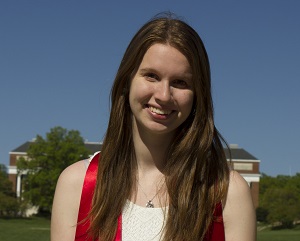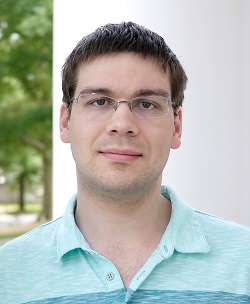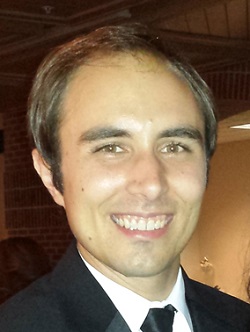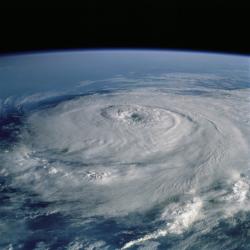Three College Alumni Receive 2017 NASA Earth and Space Science Fellowships
Lynn Montgomery, Thomas Rimlinger and Nicholas Zube receive awards of up to $45,000 per year
Three alumni of the University of Maryland College of Computer, Mathematical, and Natural Sciences have been awarded 2017 NASA Earth and Space Science Fellowships. The purpose of the fellowships is to ensure continued training of a highly qualified workforce in disciplines needed to achieve NASA’s scientific goals.
Lynn Montgomery, Thomas Rimlinger and Nicholas Zube will each receive the award, which provides up to $45,000 a year toward a stipend and other expenses.
 Lynn Montgomery (B.S. ’16, atmospheric and oceanic science), Ph.D. student in atmospheric and oceanic sciences at the University of Colorado Boulder
Lynn Montgomery (B.S. ’16, atmospheric and oceanic science), Ph.D. student in atmospheric and oceanic sciences at the University of Colorado Boulder
Advisor: Lora Koenig, research scientist, Cooperative Institute for Research in Environmental Sciences and National Snow and Ice Data Center
“Hidden Water: Investigating the Greenland firn aquifer and implication for sea level”
Melted water from Greenland’s ice sheet may increasingly contribute to sea level change in the future. As a result, scientists must accurately measure water freezing onto or melting off the Greenland ice sheet. Current calculations use NASA satellites and airborne radar to measure the sheet’s elevation and find surface water. However, water can also “hide” inside the sheet—especially in the firn, a thick layer of packed snow that coats ice sheets—and throw off estimates. To improve this methodology, Montgomery will investigate how changes in ice sheet density due to changes in hidden water can affect ice sheet height. She will use that information to find undiscovered subsurface water, investigate how subsurface water impacts ice sheet mass and improve understanding of the Greenland ice sheet’s hydrology.
 Thomas Rimlinger (B.S. ’14, astronomy; B.S. ’14, mathematics), Ph.D. student in astronomy at the University of Maryland
Thomas Rimlinger (B.S. ’14, astronomy; B.S. ’14, mathematics), Ph.D. student in astronomy at the University of Maryland
Advisor: Douglas Hamilton, professor of astronomy
“Formation and evolution of Titan and Hyperion”
Rimlinger will research the origins of Titan and Hyperion, two of Saturn’s moons. Titan, Saturn’s largest moon, boasts a uniquely large mass, dense atmosphere, relatively large eccentricity and orbital tilt. In addition, Titan always completes four orbits for every three orbits by Hyperion. Because no standard model explains these properties of the two moons, Rimlinger will simulate satellite systems to investigate the theory that Titan and Hyperion both arose from an ancient set of small moons that eventually merged into larger moons. These findings may provide clues to how other moons—including Earth’s—may have formed.
 Nicholas Zube (B.S. ’15, astronomy; B.S. ’15, physics), Ph.D. student in earth and planetary sciences at the University of California, Santa Cruz
Nicholas Zube (B.S. ’15, astronomy; B.S. ’15, physics), Ph.D. student in earth and planetary sciences at the University of California, Santa Cruz
Advisor: Francis Nimmo, professor of earth and planetary sciences
“Testing different accretion scenarios with the hafnium/tungsten (Hf/W) isotopic system”
Hafnium and tungsten isotope signatures can help establish when and how the core of a planet formed. Zube seeks to determine whether scenarios of planetary formation, such as the “grand tack” model, can recreate the physical conditions necessary to form Earth and Mars with hafnium and tungsten isotopes matching values recorded in the present day. He will also use the hafnium/tungsten system to gain a better understanding of how and under what conditions Earth's moon formed, seeking to explain the isotopic similarities between Earth and its moon. Zube’s results could improve our understanding of how the solar system formed, as well as provide a framework for using isotopes to evaluate planetary accretion models.
###
Media Relations Contact: Irene Ying, 301-405-5204, zying@umd.edu
University of Maryland
College of Computer, Mathematical, and Natural Sciences
2300 Symons Hall
College Park, MD 20742
www.cmns.umd.edu
@UMDscience
About the College of Computer, Mathematical, and Natural Sciences
The College of Computer, Mathematical, and Natural Sciences at the University of Maryland educates more than 7,000 future scientific leaders in its undergraduate and graduate programs each year. The college’s 10 departments and more than a dozen interdisciplinary research centers foster scientific discovery with annual sponsored research funding exceeding $150 million.







